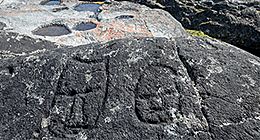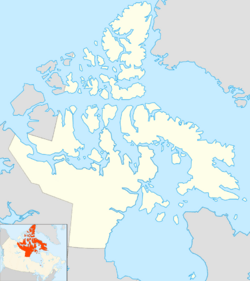Qajartalik facts for kids

Petroglyphs at Qajartalik
|
|
| Alternative name | JhEv-1 |
|---|---|
| Location | Qikertaaluk Island, Nunavut, Canada |
| Coordinates | 61°19′53.6664″N 71°29′58.7184″W / 61.331574000°N 71.499644000°W |
| Type | Petroglyph |
| History | |
| Cultures | Dorset culture |
Qajartalik is a special place in Nunavut, Canada. Its name means "where there is a kayak" in Inuktitut, the language of the Inuit people. This site is famous for its more than 150 carvings of faces, called petroglyphs, made in soft rock called soapstone.
These amazing carvings were made by the Dorset people. They lived in the eastern Arctic parts of Canada and Greenland a very long time ago, starting about 2,200 years ago. They disappeared around 1,000 years ago, before the Thule Inuit arrived about 800 years ago. Qajartalik is thought to be the most northern rock art site in North America. It is truly one of a kind! Canada hopes to add this site to the UNESCO World Heritage List, which protects important places around the world.
Contents
Exploring the Qajartalik Site
The Qajartalik site is found on Qikertaaluk Island. It is about 50 meters from the ocean and 15 meters above sea level. The site is about 130 meters long and shaped a bit like a long, narrow valley. Here, you can find several areas of soapstone rock where the petroglyphs were carved.
How the Site Was Used
The Dorset people used this site not only for carving faces but also as a quarry. A quarry is a place where people dig out rock. They used the soapstone to make important items like oil lamps and containers. Later, the Thule and Inuit people also used this site as a quarry. They made oil lamps, cooking pots, and even sculptures from the soapstone. Experts have found over 150 places where soapstone was removed from the site. Even though the Thule and Inuit used the quarry, only the Dorset people made the petroglyph carvings. We don't know exactly when the carvings were made because the site has not been scientifically dated.
The Amazing Carvings
Most of the carvings at Qajartalik show human faces. But some also look like animal faces. Interestingly, some faces seem to have a mix of both human and animal features! Some parts of the rock have just one carving, while others have groups of ten or more faces. These groups of faces are not always facing the same direction.
The carvings come in different sizes. The smallest ones are only 2-3 centimeters, while the largest are more than 70 centimeters! The smaller carvings were made by cutting into the rock with sharp tools. The larger carvings were made by hitting and grooving the rock with hammerstones.
Discovery and Study
Local Inuit people knew about the Qajartalik site for many years. An anthropologist named Bernard Saladin d’Anglure first wrote about it in the 1960s. He learned about the site from Inuit hunters who camped on Qikertaaluk Island. He first found 95 carvings. By making copies of some carvings, he figured out that the Dorset people had made them. Over the years, archaeologists visited and studied the site. In 1996, the Avataq Cultural Institute made a detailed list of all the carvings and features at the site.
Protecting Qajartalik
Since 1996, the Avataq Cultural Institute has been working hard to study and protect the Qajartalik site. They want to make sure this special place is safe for future generations.
Efforts to Preserve the Site
In 2006, some damage was found at the site, likely caused by vandals. This made people realize that the site needed more protection. On December 20, 2017, Canada's Environment Minister, Catherine McKenna, announced that Qajartalik was one of eight new sites being considered for the UNESCO World Heritage List. This list includes places around the world that are very important to human history and culture. The official request to add Qajartalik to the list was sent on April 13, 2018.
Parks Canada believes Qajartalik is a unique archaeological site in the Canadian Arctic. It provides a clear link to the culture and traditions of the ancient Dorset people.


